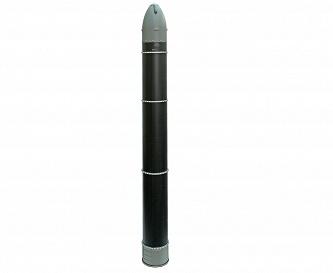The Russian Makeyev State Rocket Center has published the first image of the Sarmat intercontinental ballistic missile. The Sarmat intercontinental ballistic missile will replace the R-36M2 Voyevoda system in the divisions in service in the Krasnoyarsk Territory, in eastern Siberia and in the Orenburg region, in the southern Urals. The super-heavy intercontinental ballistic missiles, each Sarmat could carry up to fifteen Mirv / Marv warheads, will be deployed to cover possible targets in Uzhur and in the Dombarovsky area. The flight paths to the potential targets will be those above the North Pole and the South Pole.
The flight tests will not start before the end of the first quarter of next year, considering that the program would have accumulated seven months late. However, the first stage of the Sarmat missile engine has been successfully tested: previously identified technical problems have been solved. The tests, set for last March, had been postponed until the second half of the year. The Russian Missile Forces have resumed preparations for the launch of the new Sarmat intercontinental ballistic missile. The huge size of the missile required refurbishing the silos that were completed last April at the Plesetsk space center in northwest Russia. The problems encountered, but not revealed, concerned the prototype.
The Russians will continue to validate the features in various real tests so as to avoid unpleasant incidents, as happened for the UR-100 missiles: the latter, already put into service, proved unable to hit long-range targets due to the excessive vibration of the hull that destroyed its structure. The country's leadership forgot to test the missile at its maximum range, authorizing the serial production of a system unable to hit the long-range target.
The over-hundred-ton super-heavy thermonuclear missile, however, will enter service two years late, but by the end of the 2018. Under development from the 2015 in response to the American Prompt Global Strike system, the liquid propellant rocket is intended to replace the entire deterrent line formed by the SS-18 Satans, the largest solid intercontinental ballistic missile in the world ever made and entered service in the 1967. The Sarmat has an estimated range of over twelve thousand km. It was designed to reach Mach 20 and storm the targets by releasing ten heavy or fifteen lightheads with independent multiple indentation. Probably, when it comes into service it will be equipped exclusively with Marv magazines, immune to all sorts of existing defensive shields. The Russians intend to replace by 2025, the 80% of the entire ground-based nuclear arsenal with the Sarmat. The new ICBM will be in service with seven regiments of the Strategic Missile Forces of the Russian Federation. Both the Sarmat and the Satan are more powerful than the Minutemen who will remain in service at least until the 2030 with a series of updates.












